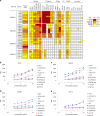Broadly neutralizing plasma antibodies effective against autologous circulating viruses in infants with multivariant HIV-1 infection
- PMID: 32879304
- PMCID: PMC7468291
- DOI: 10.1038/s41467-020-18225-x
Broadly neutralizing plasma antibodies effective against autologous circulating viruses in infants with multivariant HIV-1 infection
Abstract
Broadly neutralizing antibodies (bnAbs) develop in a subset of HIV-1 infected individuals over 2-3 years of infection. Infected infants develop plasma bnAbs frequently and as early as 1-year post-infection suggesting factors governing bnAb induction in infants are distinct from adults. Understanding viral characteristics in infected infants with early bnAb responses will provide key information about antigenic triggers driving B cell maturation pathways towards induction of bnAbs. Herein, we evaluate the presence of plasma bnAbs in a cohort of 51 HIV-1 clade-C infected infants and identify viral factors associated with early bnAb responses. Plasma bnAbs targeting V2-apex on the env are predominant in infant elite and broad neutralizers. Circulating viral variants in infant elite neutralizers are susceptible to V2-apex bnAbs. In infant elite neutralizers, multivariant infection is associated with plasma bnAbs targeting diverse autologous viruses. Our data provides information supportive of polyvalent vaccination approaches capable of inducing V2-apex bnAbs against HIV-1.
Conflict of interest statement
The authors declare no competing interests.
Figures





Similar articles
-
A Rare Mutation in an Infant-Derived HIV-1 Envelope Glycoprotein Alters Interprotomer Stability and Susceptibility to Broadly Neutralizing Antibodies Targeting the Trimer Apex.J Virol. 2020 Sep 15;94(19):e00814-20. doi: 10.1128/JVI.00814-20. Print 2020 Sep 15. J Virol. 2020. PMID: 32669335 Free PMC article.
-
An HIV-1 Broadly Neutralizing Antibody from a Clade C-Infected Pediatric Elite Neutralizer Potently Neutralizes the Contemporaneous and Autologous Evolving Viruses.J Virol. 2019 Feb 5;93(4):e01495-18. doi: 10.1128/JVI.01495-18. Print 2019 Feb 15. J Virol. 2019. PMID: 30429339 Free PMC article.
-
Viral Characteristics Associated with Maintenance of Elite Neutralizing Activity in Chronically HIV-1 Clade C-Infected Monozygotic Pediatric Twins.J Virol. 2019 Aug 13;93(17):e00654-19. doi: 10.1128/JVI.00654-19. Print 2019 Sep 1. J Virol. 2019. PMID: 31217240 Free PMC article.
-
Development of broadly neutralizing antibodies in HIV-1 infected elite neutralizers.Retrovirology. 2018 Sep 5;15(1):61. doi: 10.1186/s12977-018-0443-0. Retrovirology. 2018. PMID: 30185183 Free PMC article. Review.
-
Development of an anti-HIV vaccine eliciting broadly neutralizing antibodies.AIDS Res Ther. 2017 Sep 12;14(1):50. doi: 10.1186/s12981-017-0178-3. AIDS Res Ther. 2017. PMID: 28893278 Free PMC article. Review.
Cited by
-
Design of human immunodeficiency virus-1 neutralizing peptides targeting CD4-binding site: An integrative computational biologics approach.Front Med (Lausanne). 2022 Nov 18;9:1036874. doi: 10.3389/fmed.2022.1036874. eCollection 2022. Front Med (Lausanne). 2022. PMID: 36465923 Free PMC article.
-
Comparative analysis of within-host dynamics of acute infection and viral rebound dynamics in postnatally SHIV-infected ART-treated infant rhesus macaques.bioRxiv [Preprint]. 2024 May 23:2024.05.21.595130. doi: 10.1101/2024.05.21.595130. bioRxiv. 2024. Update in: Epidemics. 2024 Sep;48:100780. doi: 10.1016/j.epidem.2024.100780. PMID: 38826467 Free PMC article. Updated. Preprint.
-
A Rare Mutation in an Infant-Derived HIV-1 Envelope Glycoprotein Alters Interprotomer Stability and Susceptibility to Broadly Neutralizing Antibodies Targeting the Trimer Apex.J Virol. 2020 Sep 15;94(19):e00814-20. doi: 10.1128/JVI.00814-20. Print 2020 Sep 15. J Virol. 2020. PMID: 32669335 Free PMC article.
-
Impact of Delayed Early Antiretroviral Therapy Initiation on Treatment Outcomes in Infant Macaques Exposed to SHIVAD8.Viruses. 2025 Jun 14;17(6):849. doi: 10.3390/v17060849. Viruses. 2025. PMID: 40573440 Free PMC article.
-
Replication in the presence of dengue convalescent serum impacts Zika virus neutralization sensitivity and fitness.Front Cell Infect Microbiol. 2023 Mar 9;13:1130749. doi: 10.3389/fcimb.2023.1130749. eCollection 2023. Front Cell Infect Microbiol. 2023. PMID: 36968111 Free PMC article.
References
-
- Kwong PD, Mascola JR. HIV-1 vaccines based on antibody identification, B cell ontogeny, and epitope structure. Immunity. 2018;48:855–871. - PubMed
Publication types
MeSH terms
Substances
LinkOut - more resources
Full Text Sources
Medical
Molecular Biology Databases
Miscellaneous

